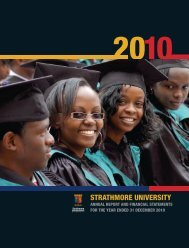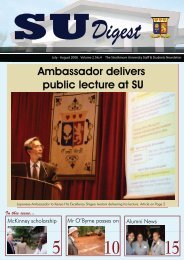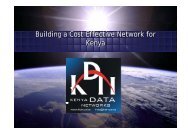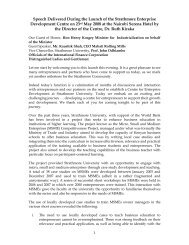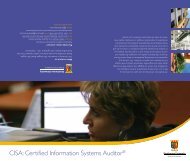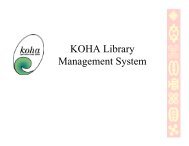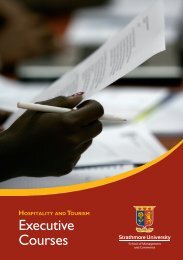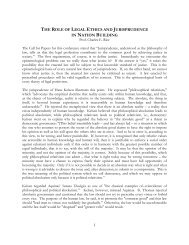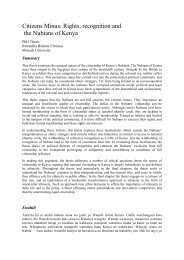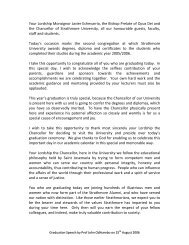Prof John Odhiambo - Strathmore University
Prof John Odhiambo - Strathmore University
Prof John Odhiambo - Strathmore University
You also want an ePaper? Increase the reach of your titles
YUMPU automatically turns print PDFs into web optimized ePapers that Google loves.
Vice Chancellor <strong>Prof</strong> <strong>John</strong> W <strong>Odhiambo</strong>’s speech given at the <strong>Strathmore</strong><strong>University</strong> Maths Conference on 18 th August 2011 in the <strong>University</strong>’sAuditoriumMathematical Sciences Research and Education in Kenya<strong>Prof</strong> Crispus Kiamba, the Permanent Secretary, Ministry of Higher Education, Science &Technology; Distinguished mathematicians; Colleagues; Ladies and gentlemen.On behalf of the Academic Council of <strong>Strathmore</strong> <strong>University</strong> and the entire <strong>Strathmore</strong> family ofstudents, faculty and staff, I convey our warm greetings to you all. You are most welcome to<strong>Strathmore</strong> and to this 1 st <strong>Strathmore</strong> Mathematics Conference. We wish you enjoyable andinspiring exchange of ideas during this conference.Before I invite the Permanent Secretary to address you and officially launch the Centre and openthis conference, permit me to make a few comments on mathematics research and education inKenya today. I am inspired to do this because I am a mathematician who is born and bred by theeducation process and system in Kenya.Contributions of mathematical research to societyMathematics research has an effect on daily life in numerous ways. Mathematicians initiated amethodology for cryptography and security. The protection of information is now everybody’sconcern, in contexts ranging from credit cards to national security. Game theory, with roots inmathematics, statistics, and economics, is routinely applied today to understanding andpredicting human behavior. Medical imaging depends on solving inverse problems, and on signalde-noising. Numerical methods for partial differential equations have application in the design ofextraordinarily efficient airfoils. The mathematical theory of wavelets enables very efficientsignal compression, with applications ranging from the video entertainment industry tofingerprint analysis to many areas of science and technology. Wavelet methods are fundamentalto the new standard for image transmission.1
The application of stochastic analysis to the financial industry has resulted in the creation ofmulti-trillion dollar security markets that have facilitated the international flow of capital andcontributed to commerce and productivity. The development of reliable pricing methods forderivative securities that are used for risk management would have been impossible without theapplication of probabilistic models and stochastic analysis that have been developed over thepast thirty years.Data mining, the determination of patterns and anomalies in data, combines statistics with pureand applied mathematics as well as computer science. Analyzing and learning from data will beof increasing importance because the sheer volume of data associated with numerousapplications— biology, medicine, geo-sciences, and atmospheric sciences—is growing atastonishing rates.Finally, there is no field in the foreseeable future where mathematics will have a greater impactthan in the life sciences. The connections between the biological sciences, and the physicalsciences, mathematics and computer science are rapidly becoming deeper and more extensive.Mathematical research is a people-intensive activityMathematics is without any doubt a part of science, but its mode of operation has intrinsicspecial features. There is an unusually strong connection between the present and the past inmathematics compared with disciplines that are more dependent on advances in technology orequipment. Another feature of mathematical research is that profound contributions are veryoften made by individuals or relatively small groups of people, so that individualism remains abedrock of discovery in mathematics. This is not a universal truth, however: mathematicalscientists who work directly with applications sometimes belong to teams of medium and evenlarge size.Research in pure mathematics and theoretical areas of applied mathematics and statistics tends tobe built around core groups of people, as distinct from facilities or laboratories. However, it isnot at all the case that mathematicians can thrive without equipment, since software andcomputation are the usual means by which mathematical ideas are transformed from research to2
tools, for mathematicians as well as for users from other fields. In addition, powerful computersare an essential part of a wide spectrum of mathematical and statistical research—for example, ingenomics, applied cryptography, and simulation of complex physical and biological systems.Another feature of mathematics, as a discipline, is that there is an almost immediate relationshipbetween research and teaching. The artifacts of mathematics are results, insights, algorithms,techniques, and software. These forms of knowledge permit very rapid introduction of the latestresearch in the mathematical sciences to applied fields of science and technology through thetraining of graduate students. However, dissemination can occur at a fast pace only if the humancapital is at hand. Thus the ability to attract enough talented young people is a central issue notonly to the growth of mathematics but also to the health of an increasingly large part of the hightechworld.The Current State of Mathematical Sciences Research in KenyaThe importance of a sound foundation and research base in the mathematical sciences isabsolutely critical for national development in science, engineering, commerce, and technology.Without this foundation, attempts at establishing a knowledge-based economy and generatinginnovation are not likely to succeed.There is evidence of research in all the mathematical sciences (pure mathematics, appliedmathematics, statistics, and mathematics education) in universities in Kenya. However suchresearch is done predominantly by a small base of researchers who are spread across theuniversity sector. There are many instances where postgraduates, PhDs, and academic staff areworking in environments where there is no critical mass of researchers. The number of newresearchers is small and there are no structures in place to mentor and develop these researchers.The most pressing need is the development of new mathematics lecturers to enter the researchculture.Research in the mathematical sciences in Kenya suffers isolation at many levels. The inward,institution-oriented approach to research in the mathematical sciences is a significant hindrance.There is academic isolation of individuals (postgraduates and researchers) in their research3
fields; and there is institutional isolation of the mathematical sciences from its applications andrelated disciplines. A lot research in Kenya is disconnected from areas of contemporary interest.The means and the environment to produce effective research is a major constraint. Mostcritically, PhDs and academic staff do not have sufficient time to undertake high qualityresearch. Unfilled posts and increased numbers of students and courses mean increased teachingloads. Many researchers do not have effective access to research literature and necessarycomputing facilities. Significant numbers of postgraduates and academic staff are not part of aresearch culture—they tend to work alone with significant time constraints rather than in acommunity that values research activity as a priority.Research in mathematics education in Kenya is weak, there are very few researchers in this fieldand their research output is hardly visible. A lot of work needs to be done to link research topractice by communicating research in effective ways to teachers in schools.Training Mathematicians at Kenyan UniversitiesUndergraduate enrolments in mathematics are large and are likely to increase due to increase inenrolment in secondary schools. However, there are well founded concerns with a decline in thequality of the mathematical training of incoming students and the number of teachers at thesecondary school level who do not have the appropriate level of mathematical qualifications. Theformer derives from the latter, at least in part, and new efforts are needed to re-instill a love ofmathematics and the teaching of mathematics amongst school teachers.The through-put of Ph.D. programmes in mathematics is very low. The general age profile ofthe faculty is reasonable but in some areas the situation is of potential concern. In particular, thearea of statistics has outstanding scientists in the 50-and-above age group, but has experiencedand continues to experience serious difficulty recruiting young talented statisticians.Public Appreciation of MathematicsNo visible efforts are being made to raise the public awareness of the impact that mathematicalresearch has made on the modern economy. It has never been easy to communicate mathematicsto the broad public, compared to other scientific disciplines such as astronomy, biology or even4
physics. Nevertheless, it has become increasingly important that this be done, not only to be ableto attract the best young talent into the field, but also to attract the funding necessary for thelong-term health of the subject. By and large, the average citizen is not aware of the enormousadvances that have occurred in recent years, and how these advances are essential in modern daysociety. Increased efforts should be made to explore ways for communicating the vitality, utilityand beauty of mathematics to the wider society.Establishment of CARMSReflection on the current state of research and education in mathematical sciences in ouruniversities prompted <strong>Strathmore</strong> <strong>University</strong> to establish the Centre for Applied Research inMathematical Sciences to provide an environment that nurtures creative mathematics and tocontribute towards formation of the next generation of mathematical leaders. The Centre has aninternational outlook and provides a space for academics and researchers to interact, collaborateand generate new ideas and synergy. The workshops that have been going on since Monday thisweek and the plenary conference we are launching this morning demonstrate this commitment.The conferences will be on bi-annual basis but the workshops will be on ongoing basis.The Centre will expose the whole mathematical community to topical areas of research at aninternational level, and will provide new opportunities for connectivity between isolatedresearchers. It will build bridges between researchers in pure mathematics, applied mathematics,statistics, and mathematics education using a programme of workshops and seminars. The Centrewill also contribute strongly to the much-needed professional development of secondary schoolteachers in mathematics and serve as an interface between academia and industry. It will alsoprovide effective international connectivity through participation of international experts inconferences, seminars and workshops as has happened during this week; as well ascollaborations with similar institutes elsewhere.AcknowledgementWe have worked very closely with professors from the Department of Mathematics and AppliedStatistics of Maseno <strong>University</strong> to organise this conference. In this we have demonstrated that5
when our universities collaborate we can achieve a lot. I express our sincere appreciation to <strong>Prof</strong>Omolo-Ongati, <strong>Prof</strong> <strong>John</strong> Ogonji, and Dr David Stern for dedicating a lot of time in ensuring thatthis conference succeeds. There is a very strong representation from Maseno <strong>University</strong> in heretoday. We welcome you as members of CARMS - you are now members of the <strong>Strathmore</strong>mathematical community.I also express our sincere appreciation to the members of the International Advisory Board ofCARMS who are present here today. You are most welcome to <strong>Strathmore</strong>. Your presence heredemonstrates our commitment as a community of individuals bound together by a stable bond oftheir love and passion for a most beautiful, elegant and inspiring subject on earth! Workingtogether we want to take mathematics research and education to new horizons!I acknowledge with profound gratitude our appreciation to all the institutions who havecontributed materially and financially towards the success of this conference: National Councilof Science and Technology, ICEA, ANSTI, MARM (Mentoring of African Mathematicians),CEMASTEA (Centre of Math, Sc& Tech Educ.), Equity Bank, and of course the principalsponsor of the conference - <strong>Strathmore</strong> <strong>University</strong>. We will endeavour to sustain these mutuallybeneficial partnerships for the good of our country and the advancement of world civilisation.God Bless You! God Bless CARMS! God Bless Mathematics!6





